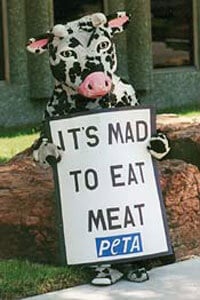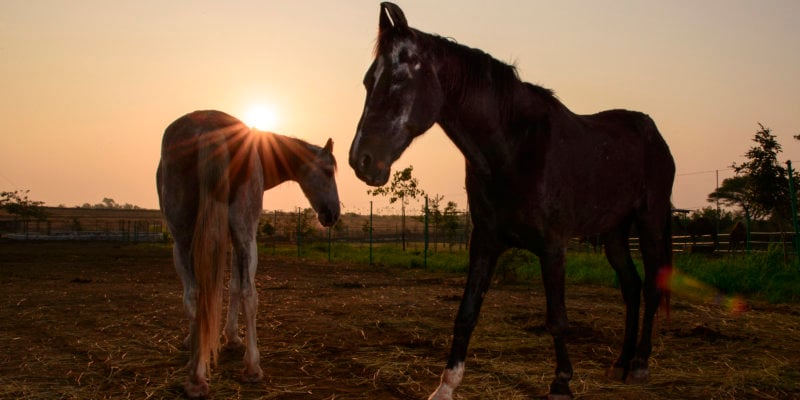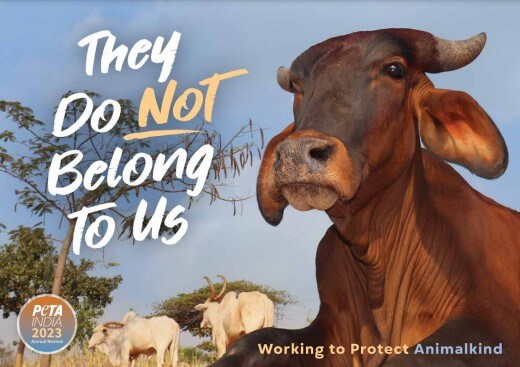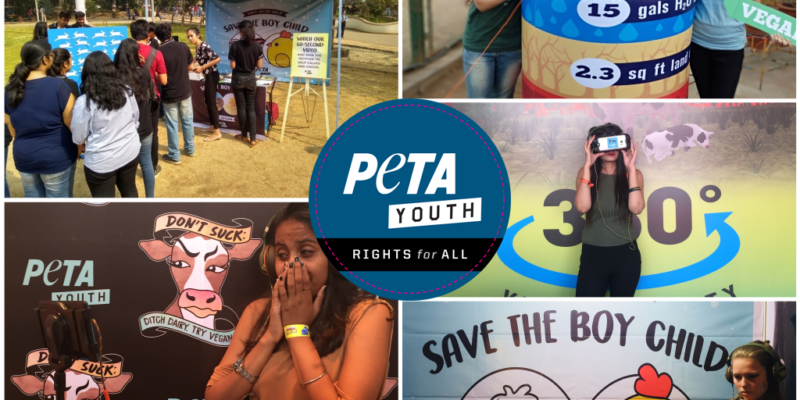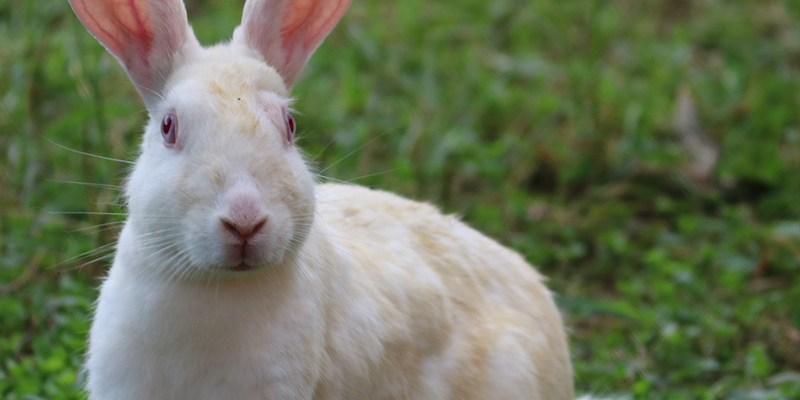Frequently Asked Questions
The responses presented here are by no means the only possible answers to common questions. They are intended as suggestions and as a source of ideas that you can use to help formulate your own responses. We recommend that you do not try to memorise and repeat these verbatim but rather use them as a guideline when discussing these issues.
General
What are “animal rights”?
When we say that animals have rights, we mean that they deserve to have their interests considered regardless of whether they are cute, useful to humans or endangered and regardless of whether any human cares about them at all.
What is the difference between “animal rights” and “animal welfare”?
Animal welfare theories acknowledge that animals have interests but allow those interests to be traded away as long as the human benefits are thought to justify that sacrifice.
Animal rights advocates believe that animals, like humans, have interests that cannot be sacrificed or traded away just because such a sacrifice might benefit others. However, the animal rights position does not hold that rights are absolute; an animal’s rights, just like those of humans, must be limited, and rights can certainly conflict.
Those who support animal rights believe that animals are not ours to eat, wear, experiment on or use for entertainment. Animal welfare proponents believe these uses are OK as long as “humane” guidelines are followed.
What rights should animals have?
Animals have the right to equal consideration of their interests. For instance, a dog most certainly has an interest in not having pain inflicted on him or her unnecessarily. We therefore are obliged to take that interest into consideration and respect that right.
However, animals don’t always have the same rights as humans because their interests are not always the same as ours and because some rights would be irrelevant to animals’ lives. For instance, a dog doesn’t have an interest in voting and therefore doesn’t have the right to vote, since that right would be as meaningless to a dog as it is to a child.
Where do you draw the line?
The renowned humanitarian Albert Schweitzer, who accomplished so much for both humans and animals in his lifetime, would take the time to stoop and move a worm from hot pavement to cool earth. Aware of the problems and responsibilities an expanded ethic brings with it, he said we each must “live daily from judgement to judgement, deciding each case as it arises, as wisely and mercifully as we can”.
We can’t stop all suffering, but that doesn’t mean we shouldn’t stop any. In today’s world of virtually unlimited choices, there are plenty of kind, gentle ways to feed, clothe, entertain and educate ourselves that do not involve killing animals.
What about plants?
The scientific community is just beginning to recognize plants’ advanced capabilities, and we now know that they experience a variety of sensations. They can close or open up to avoid an attack or to await rain, for instance. Studies show that plants can feel a touch as light as a caterpillar’s footsteps and send out signals—similar to those sent by the human body—to warn their other leaves to release bad-tasting chemicals in order to deter damaging insects. Studies show that plants also communicate with one another; share medicinal compounds with other plants through their roots, an underground fungal network, and the air; release pheromones; see, hear, smell, and react to dangers in the environment via sensing proteins; pass knowledge on to younger plants; and more.
Just as at one time, many people did not realize that octopuses—whose nervous systems differ significantly from that of humans and other animals—are extremely intelligent and sensitive to pain, it’s possible that plants have intelligence and sentience that humans cannot yet detect. Perhaps one day, we will learn that they have ways of experiencing pain that we have yet to comprehend.
Whether or not that’s the case, there is no need to harm plants unnecessarily. While we must eat in order to survive, we can harm fewer plants by going vegan, because eating plants directly, rather than feeding them to animals and then killing those animals for their flesh, requires far fewer plants and hurts fewer animals who, we already know for sure, feel pain. Cows, for example, must consume 16 pounds of vegetation to yield 1 pound of flesh, so by being vegan, we save many more plants’ lives than if we ate meat. And of course, vegans also save nearly 200 animals every year—living, feeling beings who, scientists now know beyond a shadow of a doubt, experience the full range of sensations and emotions, including pain, discomfort, fear, and sadness.
Whether it can be proved that plants experience pain or not, vegan foods are the compassionate choice because they require the deaths of fewer plants and animals.
It’s fine for you to believe in animal rights, but you shouldn’t tell other people what to do.
Now you are telling me what to do!
Everybody is entitled to his or her own opinion, but freedom of thought is not the same thing as freedom of action. You are free to believe whatever you want as long as you don’t hurt others. You may believe that animals should be killed, that black people should be enslaved or that women should be beaten, but you don’t always have the right to put your beliefs into practice.
As for telling people what to do, society exists in part to create and enforce rules that govern people’s behaviour. The very purpose of reform movements is to tell others what to do – don’t use humans as slaves, don’t sexually harass women, etc – and all movements initially encounter opposition from people who want to continue taking part in the criticised behaviour.
Animals don’t reason, don’t understand rights and don’t always respect our rights, so why should we apply our ideas of morality to them?
We apply our notions of morality to animals because an animal’s inability to understand and adhere to our rules is as irrelevant as a child’s or a developmentally disabled person’s ability to do so. Animals are not usually capable of choosing to change their behaviour, but human beings have the intelligence to choose between behaviour that hurts others and behaviour that doesn’t.
It’s almost impossible to avoid using all animal-derived products. If you’re still causing animal suffering without realising it, what’s the point?
It is impossible to live your life without causing some harm; we’ve all accidentally stepped on ants or breathed in gnats, but that doesn’t mean we should intentionally cause unnecessary harm. Just because you might accidentally hit someone with your car is no reason to run someone over on purpose.
What about all the customs, traditions and jobs that depend on using animals?
The invention of the automobile and the end of World War II, for example, also unavoidably led to job retraining and restructuring. This is simply a part of all social progress – not a reason to deter progress.
How can you justify spending your time on animals when there are so many people who need help?
There are very serious problems in the world that deserve our attention; cruelty to animals is one of them. We should try to alleviate suffering wherever we can. Helping animals is not any more or less important than helping human beings – they are both important. Animal suffering and human suffering are interconnected.
Aren’t most animals who are used for food, fur or experiments bred for that purpose?
Being bred for a certain purpose does not change an animal’s biological capacity to feel pain and fear.
Since animals who are kept in cages on factory farms or in laboratories have never known anything else, they don’t suffer that much, do they?
Being prevented from engaging in basic instinctual behaviour causes tremendous suffering. Even animals who have been caged since birth feel the need to move around, groom themselves, stretch their limbs or wings and exercise. Herd animals and flock animals become distressed when they are forced to live in isolation or when they are put into groups so large that they are unable to recognise other members. In addition, all confined animals suffer from intense boredom – some so intensely that their confinement can lead to self-mutilation or other self-destructive behaviour.
If all forms of animal exploitation were wrong, they would all be illegal, wouldn’t they?
Legality is no guarantee of morality. Who does and doesn’t have legal rights is determined merely by the opinion of today’s legislators. The law changes as public opinion or political motivations change, but ethics are not so arbitrary. Look at some of the other things that were once legal – human slavery and the oppression of women, for example.
Have you ever been to a slaughterhouse or vivisection laboratory?
No, but enough people have filmed and written about what goes on in these places to tell the story. You do not need to experience the abuse of animals close up to be able to criticise it any more than you need to personally experience rape or child abuse to be able to criticise those immoral acts. No one will ever be witness to all the suffering in the world, but that doesn’t mean we shouldn’t try to stop suffering whenever we can.
Animals are not as intelligent or advanced as humans, are they?
If possessing superior intelligence does not entitle one human to abuse another human for his or her purposes, why should it entitle humans to abuse non-humans?
Some animals are unquestionably more intelligent, creative, aware, communicative and capable of using language than some humans (for example, a chimpanzee is “smarter” than a human infant or a person with a severe developmental disability). Should the more intelligent animals have rights and the less intelligent humans be denied rights?
Conditions on factory farms and fur farms aren’t any worse than conditions in the wild, where animals die of starvation, disease or predation, are they? At least the animals on factory farms are fed and protected.
This same argument was once used by US slave owners, who claimed that African-Americans were better off as slaves on plantations than as free men and women. People in prison are also fed and protected, yet a prison sentence is considered one of society’s harshest punishments.
Animals on factory farms suffer so much that it is inconceivable that they could be worse off in the wild. The wild isn’t “wild” to the animals who live there; it’s their home. There they have their freedom and can engage in activities that are natural and important to them. The fact that they might suffer in the wild is no reason to ensure that they suffer in captivity.
Vegetarianism
Vegetarianism is a personal choice, isn’t it? Why are you trying to force it on everyone else?
From a moral standpoint, actions that harm others are not matters of personal choice. Murder, child abuse and cruelty to animals are all immoral. Our society now encourages meat-eating and factory farming, but history teaches that society also once encouraged slavery, child labour and many other practices that are now universally recognised as wrong.
Animals kill other animals for food, so why shouldn’t we?
Most of the animals who kill for food could not survive if they didn’t do so. On the other hand, we can easily survive on a plant-based diet. We are better off not eating meat. Many other animals are vegetarians, including some of our closest primate relatives. Why don’t we look to them as our example instead of to carnivores?
The animals have to die sometime, don’t they?
Humans do, too, but that doesn’t give you the right to kill them or cause them a lifetime of suffering.
Farmers have to treat their animals well or they won’t produce as much milk or lay as many eggs, will they?
More and more animals in India are being raised on factory farms. These animals do not gain weight, lay eggs and produce milk because they are comfortable, content or well cared for but rather because they have been manipulated to do these things through the use of genetic tinkering, medications, hormones and management techniques. In addition, animals raised for food today are slaughtered at extremely young ages, usually before disease and misery can kill them.
Because such huge numbers of animals are raised for food, it is less expensive for farmers to absorb some losses than it is to provide humane conditions.
What will we do with all those chickens, cows and pigs if everyone goes vegetarian?
It is unrealistic to expect that everyone will stop eating animals overnight. As the demand for meat decreases, the number of animals bred will decrease. Farmers will stop breeding so many animals and will turn to other types of agriculture. When there are fewer of these animals, they will be able to live more natural lives.
If everyone went vegetarian, many animals would not even be born. Wouldn’t that be worse for animals?
Life on factory farms is so miserable that it is hard to see how we are doing animals a favour by breeding them, confining them, tormenting them and then slaughtering them.
If everyone switches to a diet consisting solely of vegetables, grains and other plant-based foods, will there be enough to eat?
Yes. We feed so much grain to animals in order to fatten them up for consumption that if we all went vegetarian, we could produce enough food to feed the entire world. In the US, for example, animals are fed more than 80 per cent of the corn the country grows and more than 95 per cent of the oats. The world’s cattle alone consume a quantity of food that could provide the caloric needs of 8.7 billion people – which is greater than the entire human population.
Don’t vegetarians have difficulty getting enough protein?
The real problem is that many people are at risk of getting too much protein, not too little. Most meat-eaters consume about seven times as much protein as they need! Vegetarians can get enough protein from whole-wheat bread, potatoes, beans, corn, peas, mushrooms or broccoli – indeed, almost every food contains protein. Unless you eat a great deal of junk food, it’s almost impossible to eat as many calories as you need for good health without getting enough protein.
By contrast, too much protein is a major cause of osteoporosis and contributes to kidney failure and other diseases of affluence.
Don’t humans have to eat meat to stay healthy?
Both the US Department of Agriculture and the American Dietetic Association have endorsed vegetarian diets. Studies have also shown that vegetarians have stronger immune systems than meat-eaters and that meat-eaters are almost twice as likely to die of heart disease, are 60 per cent more likely to die of cancer and are 30 per cent more likely to die of other diseases. The consumption of meat and dairy products has been conclusively linked to diabetes, arthritis, osteoporosis, clogged arteries, obesity, asthma and impotence.
Isn’t eating meat natural? Hasn’t it been going on for thousands of years? Aren’t our bodies designed to eat meat?
Actually, human bodies are better suited to a vegetarian diet. Carnivorous animals have long, curved fangs, claws and a short digestive tract. Humans have flat, flexible nails, and our so-called “canine” teeth are minuscule compared to those of carnivores and even compared to those of vegetarian primates such as gorillas and orang-utans. Our tiny canine teeth are better suited to biting into fruit than tearing through tough hides. We have flat molars and a long digestive tract that is suited to a diet of vegetables, fruits and grains. Eating meat is hazardous to our health; it contributes to heart disease, cancer and many other health problems.
What’s wrong with drinking milk? Don’t dairy cows need to be milked?
In order for a cow to produce milk, she must have a calf. “Dairy cows” are impregnated every year so that they will provide a steady supply of milk. In the natural order of things, the cow’s calf would drink her milk (eliminating her need to be milked by humans). But the babies of cows on dairy farms are taken away within a day or two of birth so that humans can have the milk that is intended for the calves. Female calves on dairy farms are slaughtered immediately or raised to produce milk. Male calves are often killed immediately or confined to tiny veal crates that are too small for them even to turn around in.
Because of the high demand for dairy products, cows must be pushed beyond their natural limits, genetically engineered and fed growth hormones so that they will produce huge quantities of milk. Even the few farmers who choose not to raise animals intensively must get rid of the calf (who would otherwise drink the milk) and eventually send the mother off to slaughter or release her to live on the street after her milk production wanes.
I know a vegetarian who is unhealthy. What about that?
Some vegetarians are unhealthy. But doctors agree that vegetarians who eat a varied, low-fat diet stand a much better chance of living longer, healthier lives than their meat-eating counterparts.
Why blame me? I didn’t kill the animal.
No, but you hired the killer. Whenever you purchase meat, you can be sure that the killing was done for you and that you paid for it.
If you were starving on a boat at sea and an animal was on the boat, would you eat him or her?
I don’t know. Humans will go to extremes to save their own lives, even if it means hurting an innocent living being. (People have even killed and eaten other people in such situations.) This example, however, isn’t relevant to our daily choices. For most of us, there is no emergency and no excuse for killing animals for food.
Since chickens lay eggs naturally, isn’t it OK to eat eggs? The eggs we buy in the supermarket are sterile and are not unborn foetuses, right?
That is true. However, egg production is cruel not because eggs are destroyed but because “laying hens” are perhaps the most abused of all factory-farmed animals. The number of factory farms in India is growing. Each egg from a modern factory farm represents 22 hours of misery for a hen who is packed with as many as five other chickens in a cage the size of a filing cabinet drawer. Cages are stacked many tiers high, and faeces from cages above fall onto the chickens below. Hens become lame and develop osteoporosis as a result of forced immobility and the calcium that they lose when they produce eggshells. Some birds’ feet grow around the wire cage floors, and as a result, the animals starve to death because they are unable to reach the food trough. By the time they are just 2 years old, most hens are “spent”, and they are then sent to the slaughterhouse. Egg-laying operations don’t have any use for male chicks, so they are killed by suffocation, decapitation or crushing or are ground up alive.
Vivisection
Hasn’t every major medical advance resulted from experiments on animals?
Medical historians have shown that since 1900, improved nutrition, sanitation and other behavioural and environmental factors – not anything learned from animal experiments – have been responsible for the decline in deaths from the most common infectious diseases and that medicine has had little to do with increased life expectancy. Many of the most important advances in health are attributable to studies of humans. Among these advances are the development of anaesthesia, bacteriology, germ theory, the stethoscope, morphine, penicillin, artificial respiration, antiseptics, X-rays and CAT, MRI and PET scans as well as the use of radium, the discovery of the relationships between cholesterol and heart disease and smoking and cancer and the isolation of the virus that causes AIDS. Animal testing played no role in these and many other developments.
Is it really feasible to stop using animals for basic medical research considering that researchers need to observe the complex interactions of cells, tissues and organs?
Regardless of the moral issues involved, clinical and epidemiological studies of humans offer a far more accurate picture without hurting anyone. Even when we are able to observe interactions in animals, we cannot guarantee that the information can be extrapolated to humans. Different species of animals vary enormously in their reactions to toxins and diseases and in the ways that they metabolise drugs. For example, a dose of aspirin that is therapeutic in humans is poisonous to cats and has no effect on fever in horses; benzene causes leukaemia in humans but not in mice; insulin produces birth defects in animals but not in humans and so on. Animal experiments cannot replace careful clinical observation of human beings.
But weren’t many treatments we have today – such as the polio vaccine – developed on animals?
Actually, two separate bodies of work were done on polio – the in vitro work, which did not involve animals and which resulted in a Nobel Prize, and the subsequent animal tests, which killed close to 1 million animals and which the Nobel committee refused to recognise as anything more than wasteful. Also, polio died out just as quickly in areas of the world that did not use the vaccine as it did in areas where it was used.
However, some medical developments did result from the use of cruel animal tests. But just because animals were used doesn’t mean they had to be used or that primitive techniques that were used in the 1800s are valid today. Throughout medical history, very few resources have been devoted to non-animal research methods, so it’s impossible to say where we would be if we had declined to experiment on animals. In fact, because animal experiments frequently yield misleading results with regard to human health, we’d probably be better off if we hadn’t relied on them.
Don’t scientists have the responsibility to use animals in order to keep looking for cures for the diseases people suffer from?
Educating people and encouraging them to avoid fat and cholesterol, quit smoking, reduce their consumption of alcohol and other drugs, exercise regularly and clean up the environment will save more human lives and prevent more human suffering than all the animal tests in the world. Animal tests are primitive – and besides, modern technology and human clinical tests are more effective and reliable.
Even if researchers could prove that we have no alternative to using animals – which they can’t – animal testing would still be ethically unacceptable. As George Bernard Shaw once said, “You do not settle whether an experiment is justified or not by merely showing that it is of some use. The distinction is not between useful and useless experiments, but between barbarous and civilised behaviour”. After all, there are some medical problems that can probably only be cured by testing on unwilling people, but we don’t conduct such tests, because we recognise that it would be wrong to do so.
If we couldn’t use animals, wouldn’t we have to test new drugs on people?
The choice isn’t between animals and people. There is no guarantee that drugs are safe just because they’ve been tested on animals. Because of the physiological differences between humans and other animals, results from animal tests cannot be accurately extrapolated to humans. This leaves us vulnerable to exposure to drugs that can cause serious side effects.
Ironically, unfavourable animal test results do not prevent a drug from being marketed for human use. So much evidence has accumulated about differences in the effects that chemicals have on animals and humans that government officials often do not act on findings from animal studies. In the last two decades, many drugs – including phenacetin, E-Ferol, Oraflex, Suprol and Selacryn – were taken off the market after causing hundreds of deaths and injuries. In fact, more than half the drugs the US Food and Drug Administration approved between 1976 and 1985 were either removed from the market or relabelled because they caused serious side effects. If the pharmaceutical industry switched from animal experiments to quantum pharmacology and in vitro tests, we would enjoy greater protection, not less.
If we didn’t test on animals, how would we conduct medical research?
Using cadavers, computer simulators and human clinical and epidemiological studies is faster, more reliable, less expensive and more humane than using animal tests. Ingenious scientists have used human brain cells to develop a model “microbrain” that can be used to study tumours. They have also developed artificial skin and artificial bone marrow. We can now test irritancy on egg membranes, perform pregnancy tests by using blood samples instead of killing rabbits and produce vaccines from cell cultures. As Gordon Baxter, co-founder of Pharmagene Laboratories (a company that uses only human tissues and computers to develop and test drugs), says, “If you have information on human genes, what’s the point of going back to animals?”
Doesn’t animal experimentation also help animals by advancing veterinary science?
This is like saying it’s acceptable to experiment on poor children in order to benefit rich ones. The question is not whether animal experimentation can be useful to animals or humans but whether we have the moral right to inflict unnecessary suffering on those who are at our mercy. We do not.
Don’t medical students have to dissect animals?
No, they don’t. In fact, more and more medical students are becoming conscientious objectors, and many students now graduate without ever having used animals; instead, they learn by assisting experienced surgeons. In the UK, it is against the law for medical students to practise surgery on animals, and British physicians are as competent as those who are educated elsewhere. Many leading US medical schools, including Harvard, Yale and Stanford, now use innovative, clinical teaching methods instead of old-fashioned animal laboratories. Harvard, for instance, offers a cardiac anaesthesia practicum in which students observe human heart bypass operations instead of relying on dog labs. The Harvard staff members who developed it have recommended that it be implemented elsewhere.
Should we throw out all the drugs that were tested on and developed through the use of animals? Would you refuse to take them?
Unfortunately, a number of things in our society came about as a result of exploitation. For instance, many of the roads around the world were built by slaves. We can’t change the past. Those who have already suffered and died are lost. But what we can do is change the future by using non-animal research methods from now on.
Don’t our laws protect animals from cruelty?
Animal protection laws still permit painful experiments and are poorly enforced. Animals in laboratories are often starved, electrically shocked, driven insane or burned with a blowtorch – all in the name of “science”.
Don’t most scientists care about animals? Don’t they have to care since their research depends on the animals’ well-being?
Investigations at America’s most prestigious institutions show that this is simply not the case. At the City of Hope in California, a prominent research facility, animals starved to death and drowned in their own faeces “by accident”. Many experimenters become calloused after years of research and don’t see the animals’ suffering – they treat animals as disposable tools for research. Improvements in the animals’ care are fought as “too expensive”.
What about peer review and animal care committees at institutions?
Many such committees are composed mainly or entirely of people who have vested interests in continuing animal experimentation. Animal rights advocates have had to file lawsuits in order to get these institutions to allow public access to committee meetings.
Would you allow an experiment that would sacrifice 10 animals to save 10,000 people?
Suppose the only way to save those 10,000 people was to experiment on one mentally challenged orphan. If saving people is the goal, wouldn’t that be worth it? Most people would agree that it is wrong to sacrifice one human for the “greater good” of others because it would violate that individual’s rights. But when it comes to sacrificing animals, the assumption is that human beings have rights while animals do not. Yet there is no logical reason to deny animals the same rights that protect individual humans from being sacrificed for the common good.
What about experiments that don’t harm animals but simply allow researchers to observe them?
If the experiments actually cause animals no harm, we don’t object. But “no harm” means that the animals aren’t kept isolated in barren, cold steel cages, because the stress and fear of confinement are harmful, as is evidenced by the differences in blood pressure between caged and free animals. Caged animals also suffer because they are prevented from engaging in normal behaviour and participating in social interactions.
If you were in a fire and could save only your child or your dog, whom would you choose to save?
I would save my child, but that’s just instinct. A dog would save her pup. Regardless of whom I save, however, my choice proves nothing about the moral legitimacy of experimenting on animals. I might save my own child instead of my neighbour’s child, but that hardly proves that it is morally acceptable to experiment on my neighbour’s child.



